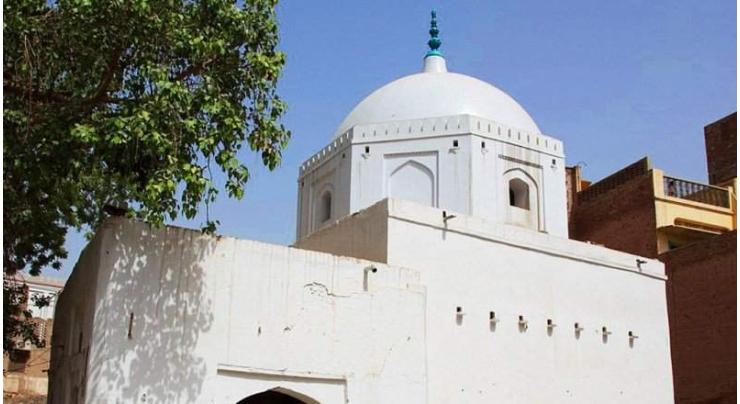
Work Begins To Conserve Shah Hussain Saddozai Tomb In Multan
Mohammad Ali (@ChaudhryMAli88) Published September 18, 2019 | 06:19 PM

Punjab Archaeology Department has started executing a Rs 8 million project to conserve the historical tomb of Shah Hussain Saddozai
The first from Saddozai clan to have settled in Multan in the mid seventeenth century.
Shah Hussain was the grandson of Asadul Ain alias Saddo Khan, the progenitor of Saddozai clan and was the first from Saddozais to have reached and settled in Multan in 1652 after he left Afghanistan (Qandhar) due to differences with the rulers at that time.
The Rs 8 million project was recently approved in 2018-19 but was deferred due to paucity of funds and set into motion in 2019-20 under Punjab annual development plan. It would be completed in two years and a sum of Rs 4 million was allocated for the year 2019-20. An amount of Rs 1 million has been released for the first quarter under a policy of releasing funds quarterly.
Shah Hussain Saddozai was given the title of Wafadaar Khan by a Mughal emperor and was allotted 'Jaageer' following which Multan became the second home to Saddozais.
The Saddozai rulers like Nawab Shuja Khan and Nawab Muzaffar Khan, and others were the descendants of Shah Hussain Saddozai.
The contractor started collecting the required material and erecting the scaffolding to reach higher points of the historical structure for its conservation from Monday last, Malik Ghulam Muhammad, the Incharge archaeology department Multan told APP on Wednesday.
The work is expected to gain momentum from Saturday, September 21, he added.
The tomb has two modern wooden doors which would be replaced by the Mughal design doors while a perforated wooden structure would also be fixed for proper ventilation.
Underpinning of salt affected portions of walls would be carried out up to a height of 12 feet on the exterior. Interior of walls would also undergo this process.
Lime plaster would be applied on the dome's interior and exterior besides walls. Lime plaster on walls and dome's interior would first be cleaned to unveil fresco designs, if any, and these would be restored. In case designs were found on unstable or weak lime plaster then designs would be traced and recreated as per original after applying fresh lime plaster.
Brick imitation and Kashi tile work would be restored on the second storey of the dome that is octagonal in shape.
Merlons of Kashi tiles on the parapet would also be restored.
The tomb's covered area has cement floor which would be replaced by Persian blue tile flooring while the open area or the courtyard would have apron with edge flooring and plinth protection.
Blue kashi tiles would also be cleaned and the weaker ones or chipped off tiles would be replaced, the official said.
Related Topics
Recent Stories

HEC reviews curricula for environmental sciences degree programme

ICC Asia looking forward to an action-packed Asia Cricket Week

Yuvraj Singh named ICC Men’s T20 World Cup 2024 Ambassador

Greece hands Olympic flame to 2024 Paris Games hosts

Two Kyiv hospitals evacuating over feared Russian strikes

World must act on neurotech revolution, say experts

Charles & Catherine's cancer diagnoses

Champions Alcaraz and Sabalenka through in Madrid Open

King Charles to resume some public duties during cancer treatment: palace

US defense chief announces $6 bn in security aid for Ukraine

Heavy rains cause damage to Spezand-Taftan railway track

Woman stabbed in Israel, attacker killed: police
More Stories From Pakistan
-
Saudi ministry warns against fraudulent Hajj schemes; urges vigilance, official channels for booking
2 hours ago -
SC to take up 9 identical petitions regarding judges' letter
2 hours ago -
Woman committed suicide in Pindigheb
2 hours ago -
Teenage girl abducted in Hassanabdal
2 hours ago -
NTDC Super 8 Inter-Departmental Tape Ball Cricket Tournament concludes: GM (HR) team clinches the w ..
3 hours ago -
AJK President calls for overseas Kashmiris' proactive role to expose the Modi government's nefarious ..
3 hours ago
-
AJK-wide campaign begins to vanish black-tinted glasses to all sorts of vehicles
3 hours ago -
Islamabad to be digitalized as pilot project under national digitalization plan: IT Minister
3 hours ago -

HEC reviews curricula for environmental sciences degree programme
3 hours ago -

Heavy rains cause damage to Spezand-Taftan railway track
3 hours ago -

Documentary on life of Jamiluddin Aali screened at embassy
3 hours ago -

"Sindh Theater Festival 2024" commences in Larkana
3 hours ago



